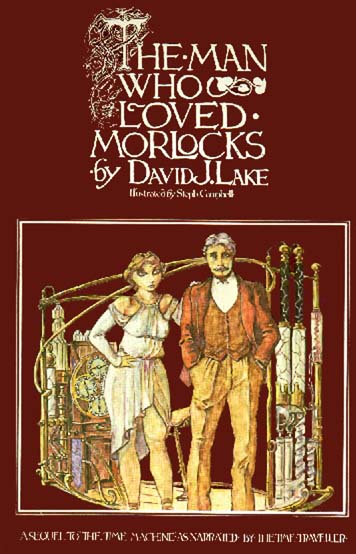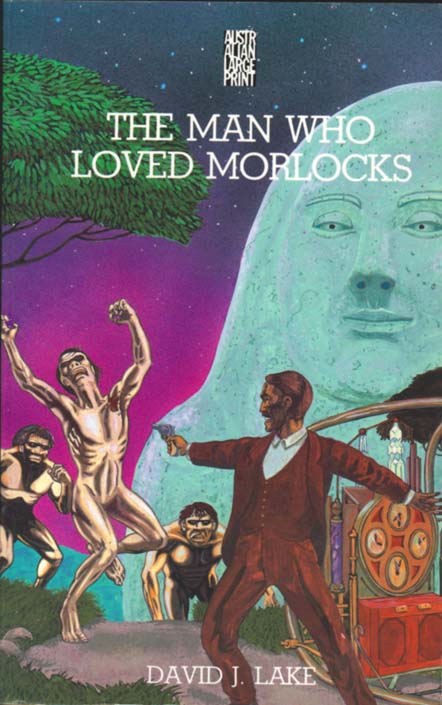 Text
on the backside of the (Australian) book
Text
on the backside of the (Australian) bookThe
Man Who Loved Morlocks
by David J. Lake
Hyland House Publishing 1981,
hardcover, 127 pages
Cover art and illustrations by Steph Campbell
Also
in:
Australian Large Print 1989, softcover, 204 pages,
Cover art by Jan Scherpinhuisen and illustrations by Steph Campbell
 Text
on the backside of the (Australian) book
Text
on the backside of the (Australian) book
On a cold Friday morning in 1892 the Time Traveller vanished, apparently forever, into the fourth dimension. His chronicler, H.G. Wells, glimpsed a ghostly figure, a blur, and the Traveller and his Machine were no more. Had he launched himself once again into the Future, or had he gone to explore the millenia of the Past?
In this sequel to H.G. Wells's The Time Machine the Time Traveller resumes his narrative. Having journeyed through Time to put his story into the hands of a publisher, we can now share the adventure of his second encounter with the Morlocks, this time equipped wth a camera - and a Colt revolver. But, prepared as he is for violent confrontation, he is totally unprepared for the subtle and ironic twists Time has in store ...
Dramatis personae
The
Time Traveller - the inventor
King Wanas - the ruler over the Lorana people
Lady Wanaquil - King Wanas's daughter
Prince Lorquas - King Wanas's son
Dr.
Kemp - psychologist, friend of the inventor
A fat little proprietor of the chemist's shop
Lorana people, Helcona people, Skolroma people, London people, Eloi and Morlocks
My review
I found this novel very intriguing, particularly of the bacterial consequenses of time travel when he tries to return to Weena and the culture shock between the Time Traveller and the spartan bronze-age Lorana people in the year 999,480. Then the problem of time paradoxes is somewhat eliminated, because the Time Traveller can't travel to places in time he already had visited and also is he blocked out from the times in the proximity of such places, creating "Barriers". But for the Time Traveller H.G. Wells is a "crammer-cum-journalist from Putney" who "turned [his] living reality into a so-called 'fiction'" and this means that this novel is not a straight sequel to the H.G Wells's novel, but a parallell one, as told by the Time Traveller himself. And in the end of the novel, the true intentions of the morlocks are revealed as a translation of an archaeological discovery of bronze plates - and they are, as said in the novel, compareable with the text of The Time Machine!
It is also interesting to know by the Time Travellers conversation with Dr. Kemp why he loaths morlocks so much and here we also get information of the Time Travellers family tragedy. And toward the end of the novel there is a very interesting philosophical-teological discussion about the Progress of mankind. What is Progress anyway? The industrial and techical Progress did only exhaust all the useful ores in the world but still the Lorana people lives in a "primitive", quite nice world. The Time Travellers conclusion is that the industrial and techical Progress is the enemy of true humanity and had banished itself from the Earth for a very, very long time.
Some small details are strange. The Time Traveller says he has only one lever ("there is not a separate stopping lever") in contradictory to the H.G. Wells's novel, then he makes a second one - for what purpose? But this is a trifle ...
Although "written"
by the Time Traveller himself and not by H.G. Wells, the novel is a pretty good
sequel to H.G. Wells's novel. It is written in a nice Wellsian style and the
only little flaw is that it is a little bit grumpy in the beginning, but only
the very first page. Read it if you like films as The
Time Machine (1960), The
Time Machine (2002), The
Planet of the Apes (1968), Kate
& Leopold (2001) and Enemy
Mine (1986) ...
As a sequel to the original
H.G. Wells novel: ![]()
![]()
![]()
![]()
As a
parallell sequel to the original H.G. Wells novel:
![]()
![]()
![]()
![]()
![]()
Sandra Petojevic, Master of Arts in Art History and Visual studies, August 28, 2005
Buy the book - and
see other reviews - on the Net:
Hyland House Publishing (1981 hardcover) N.B. This edition is very rare and
expensive! UK
John Curley and Assoc (1990 large print hardcover) UK
Rainbow Publishing (1991 paperback) UK
and USA

Back to sequels, click here.